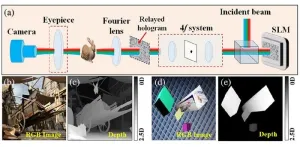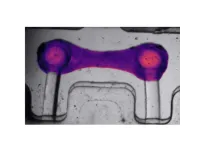(Press-News.org) Coronary artery disease and major depression may be genetically linked via inflammatory pathways to an increased risk for cardiomyopathy, a degenerative heart muscle disease, researchers at Vanderbilt University Medical Center and Massachusetts General Hospital have found.
Their report, published April 5 in the journal Nature Mental Health, suggests that drugs prescribed for coronary artery disease and depression, when used in combination, potentially may reduce inflammation and prevent the development of cardiomyopathy.
“This work suggests that chronic low-level inflammation may be a significant contributor to both depression and cardiovascular disease,” said the paper’s corresponding author, Lea Davis, PhD, associate professor of Medicine in the Division of Genetic Medicine and Vanderbilt Genetics Institute.
The connection between depression and other serious health conditions is well known. As many as 44% of patients with coronary artery disease (CAD), the most common form of cardiovascular disease, also have a diagnosis of major depression. Yet the biological relationship between the two conditions remains poorly understood.
A possible connection is inflammation. Changes in the levels of inflammatory markers have been observed in both conditions, suggesting that there may be a common biological pathway linking neuroinflammation in depression with atherosclerotic inflammation in CAD.
In the current study, the researchers used a technique called transcriptome-wide association scans to map single nucleotide polymorphisms (genetic variations) involved in regulating the expression of genes associated with both CAD and depression.
The technique identified 185 genes that were significantly associated with both depression and CAD, and which were “enriched” for biological roles in inflammation and cardiomyopathy. This suggests that predisposition to both depression and CAD, which the researchers called (major) depressive CAD, or (m)dCAD, may further predispose individuals to cardiomyopathy.
However, when the researchers scanned large electronic health record databases at VUMC, Mass General, and the National Institutes of Health’s All of Us Research Program, they found the actual incidence of cardiomyopathy in patients with the enriched genes for (m)dCAD was lower than in patients with CAD alone.
One possible explanation is that medications prescribed for CAD and depression, such as statins and antidepressants, may prevent development of cardiomyopathy by reducing inflammation, the researchers concluded.
“More research is needed to investigate optimal treatment mechanisms,” Davis added, “but at a minimum this work suggests that patient heart and brain health should be considered together when developing management plans to treat depression or cardiovascular disease.”
Kritika Singh, PhD, the paper’s first author, is a former graduate student in the Davis lab who is now a postdoctoral Innovation Fellow at Novartis in Cambridge, Massachusetts.
Other VUMC co-authors are Tyne Miller-Fleming, PhD, Peter Straub, MS, Nancy Cox, PhD, founding director of the Vanderbilt Genetics Institute, and institute members Quinn Wells, MD, PharmD, MSCI, associate professor of Medicine in the Division of the Cardiovascular Medicine, and Emily Hodges, PhD, assistant professor of Biochemistry.
The research was supported by National Institutes of Health grants R56MH120736, R01H118233, 1F31MH124306, and 1R01HL140074, and an American Heart Association Fellowship.
END
Heart disease, depression linked by inflammation: study
2024-04-08
ELSE PRESS RELEASES FROM THIS DATE:
Illinois study identifies atmospheric and economic drivers of global air pollution
2024-04-08
URBANA, Ill. – Carbon monoxide emissions from industrial production have serious consequences for human health and are a strong indicator of overall air pollution levels. Many countries aim to reduce their emissions, but they cannot control air flows originating in other regions. A new study from the University of Illinois Urbana-Champaign looks at global flows of air pollution and how they relate to economic activity in the global supply chain.
“Our study is unique in combining atmospheric transport of air pollution with supply chain analysis as it tells us where the pollution is coming ...
Advancing real-time 3D holographic display: A breakthrough in computer-generated holography
2024-04-08
Holographic displays offer a promising avenue for achieving lifelike 3D reproductions with continuous depth sensation, holding potential applications in fields such as entertainment, medical imaging, and virtual reality. However, the conventional methods for generating computer-generated holograms (CGHs) rely on repetitive computations, leading to increased computational complexity and impracticality for real-time applications.
To tackle this issue, researchers from the University of Shanghai for Science and Technology (China) have introduced a novel method for CGH generation that significantly reduces computational overhead while ...
New study shows renewable energy could work as power source at the Amundsen-Scott South Pole Station
2024-04-08
A recent analysis shows that renewable energy could be a viable alternative to diesel fuel for science at the South Pole. The analysis deeply explores the feasibility of replacing part of the energy production at the South Pole with renewable sources.
For almost as long as humans have spent time in Antarctica, the continent has been a home for science. One of the research outposts located there is the Amundsen-Scott South Pole Station. The science done there includes studies of climate change and cosmology.
Currently, ...
Cathie Biga is new American College of Cardiology president
2024-04-08
Cathie Biga, MSN, FACC, today became president of the American College of Cardiology and made history as the organization’s first non-physician president. She will serve a one-year term representing over 56,000 cardiovascular care team members around the world and leading the cardiovascular organization in its mission to transform cardiovascular care and improve heart health for all.
“I’m excited to bring my own set of leadership skills and perspectives to the ACC as we kick off the first year of our new Strategic Plan and celebrate the College’s 75th ...
Data shows medical marijuana use decreased in states where recreational use became legal
2024-04-08
Embargoed for release until 5:00 p.m. ET on Monday 8 April 2024
Annals of Internal Medicine Tip Sheet
@Annalsofim
Below please find summaries of new articles that will be published in the next issue of Annals of Internal Medicine. The summaries are not intended to substitute for the full articles as a source of information. This information is under strict embargo and by taking it into possession, media representatives are committing to the terms of the embargo not only on their own behalf, ...
Houston-area energy startup incubator wins phase 1 of DOE competition
2024-04-08
The U.S. Department of Energy’s Office of Technology Transitions (OTT) selected Texas Innovates, a non-profit organization focused on hydrogen and carbon innovation and expansion in the greater Houston and Gulf Coast region, as one of 23 phase 1 winners of the Energy Program for Innovation Clusters (EPIC) Round 3 competition. Notably, Texas Innovates is the only Texas entity to advance to phase 2 of the competition.
“We have been working towards this day since we identified the need for energy hardware incubation in 2017 and were a finalist in 2019 for C40 Cities global competition to make Houston’s Velasco Incinerator ...
A pulse of innovation: AI at the service of heart research
2024-04-08
A Pulse of Innovation: AI at the Service of Heart Research
Columbia biomedical engineers use AI to build a transformative new tool to study and diagnose heart function
Understanding heart function and disease, as well as testing new drugs for heart conditions, has long been a complex and time-consuming task. A promising way to study disease and test new drugs is to use cellular and engineered tissue models in a dish, but existing methods to study heart cell contraction and calcium handling require a good deal of manual work, are prone to errors, and need expensive specialized equipment. There clearly is a critical medical ...
Targeting vulnerability in B-cell development leads to novel drug combination for leukemia
2024-04-08
Despite having an overall survival rate of 94%, B-cell acute lymphoblastic leukemia (B-ALL), the most common childhood cancer, can prove challenging to treat, with survival among relapsed or resistant cases falling between 30-50%. Recent work by St. Jude Children’s Research Hospital scientists discovered which tumor cells resist treatment and why. This enabled the rational design of a combination therapy that better controlled high-risk subtypes of B-ALL in mouse models. The findings were published today in Cancer Cell.
“We found a new explanation of B-ALL ...
People make more patient decisions when shown the benefits first
2024-04-08
Key takeways
UCLA psychologists asked experiment participants to choose to receive $40 in seven days or $60 in 30 days, for example, under a variety of time constraints.
The experiment showed that people tend to make more impulsive decisions if they think about time delays first, and more patient decisions if they think about the greater reward associated with waiting longer.
The findings could be applied where people are being encouraged to make life choices that will benefit them in the long run, such as eating healthier, exercising or saving for retirement, by emphasizing the future large rewards and deemphasizing ...
New diagnostic tool achieves accuracy of PCR tests with faster and simpler nanopore system
2024-04-08
EMBARGOED UNTIL APRIL 8, 2024 AT 3:00 PM U.S. ET/ 12:00 PM PT
Over the past four years, many of us have become accustomed to a swab up the nose to test for COVID-19, using at-home rapid antigen tests or the more accurate clinic-provided PCR tests with a longer processing time. Now a new diagnostic tool developed by UC Santa Cruz Distinguished Professor of Electrical and Computer Engineering Holger Schmidt and his collaborators can test for SARS-CoV-2 and Zika virus with the same or better accuracy as high-precision PCR tests in a matter of hours.
In a new paper in the journal Proceedings of the National Academy of Sciences, Schmidt ...








